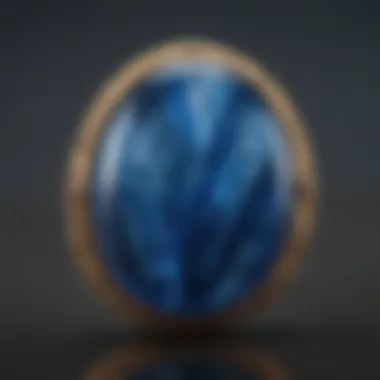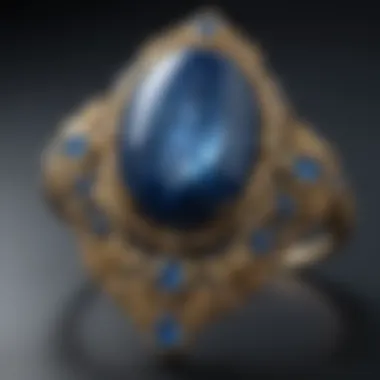Kyanite Cabochons: Essential Insights for Collectors


Intro
Kyanite cabochons have gained prominence in the world of collectors and gem enthusiasts for their distinct aesthetic qualities and rich geological background. Understanding kyanite, its formation, and characteristics is crucial for any collector hoping to appreciate its luminosity and myriad of hues. This guide aims to unravel the layers of knowledge regarding kyanite cabochons, enabling not just acquisition but also informed curation and appreciation.
Rock and Fossil Identification
Types of Rocks and Minerals
Kyanite is a metamorphic mineral originating in high-pressure environments. It often forms during the metamorphism of clay-rich rocks. Kyanite can be found in various host rocks, making it essential for collectors to distinguish kyanite from similar minerals. Other minerals like sillimanite and andalusite are often found in the same geological regions, leading to potential mix-ups. This trajectory brings us closer to identifying kyanite properly in the field.
Characteristics to Look For
Collectors should pay close attention to the following characteristics when identifying kyanite:
- Color Variants: Kyanite may appear in color ranges such as blue, green, gray, and black; the coloration often depends on impurities.
- Birefringence: Kyanite has a significant birefringence, giving it different optical properties when viewed along different axes.
- Cleavage: It is characterized by a perfect cleavage, making it easy to split, which is distinctly different from its many other associated minerals.
Tools for Identification
Having the right tools can facilitate a successful identification experience. Consider these integral tools:
- Hand Lens: Use a hand lens to closely examine the mineral's internal structures.
- Field Guide: A comprehensive field guide that includes images of kyanite can foster proper identification in the wild.
- Pocket Scale: A small scale might also help in determining the correct grading of your kyanite specimens.
Collecting Tips and Techniques
Best Practices for Collecting
Embarking on a collecting venture requires patience and knowledge. Follow good practices:
- Harvest gems ethically.
- Document specimen details, including location and date of collection.
Locating Prime Collecting Sites
Kyanite can be sourced from several regions, but prominent locations include:
- The Himalayas: Particularly in India and Nepal.
- North America: Especially in Virginia and North Carolina.
- Brazil: Notable deposits often checked for quality.
How to Safely Extract Specimens
While extracting, make sure to:
- Utilize proper tools to minimize damage.
- Preserve the integrity of forms surrounding your specimen.
Preservation and Display
Techniques for Preserving Rocks and Fossils
Optimal preservation methods sustain the quality of your kyanite cabochons over time. Follow these guidelines:
- Store in a climate-controlled environment, away from direct sunlight.
- Wrap delicate specimens in soft cloth.
Proper Storage Methods
Proper storage will prevent scratches and damage:
- Use padded boxes.
- Group by size and color.
Creative Display Ideas
Displaying kyanite can elevate your collection's presence. Some ideas include:
- Creating themed displays for aesthetic appeal.
- Incorporating them into jewelry settings that showcase their luster.
Geological Insights
Geological Formations and Processes


Kyanite forms when clay minerals undergo metamorphosis under heat and pressure. The comprehensions of this process allow collectors to appreciate the geological history embedded within each stone. More than just visual appeal, there's complexity and story felt through geological insights.
Historical Significance of Rocks and Fossils
Kyanite carries not only beauty but a storytelling lineage reflecting the Earth's geological activity. Each kabochan connects to regional histories of tectonic shifts, presenting opportunities for academic exploration.
Notable Discoveries in the Field
There have been intriguing kyanite discoveries in various locations, from historical archaeological sites to recent finds in commercial mining efforts. Notable or trapped/incased specimens often attract attention and research into their structural formation.
Kyanite holds historical and geological insights critical for anyone passionate about geology and mineral collection.
Understanding these elements should resonate effectively with both novice and seasoned collectors, helping to navigate the enchantments that kyanite cabochons offer.
Foreword to Kyanite Cabochons
Kyanite cabochons represent not just a stunning form of ornamental stone but also embody a rich geological history. In this section, we will examine the substantial relevance of kyanite cabochons in the comprehensive understanding of this remarkable mineral. The differentiation between raw kyanite and its cabochon counterparts offers considerable opportunities for collectors and enthusiasts alike. Cabochons are sought after for their aesthetic properties and intrinsic value rooted in solid geological foundations.
Kyanite, known for its unique crystal structure, varies in color and transparency, making each cabochon distinctly captivating. Understanding kyanite ensures collectors can appreciate the differences and qualities that define a gem, elevating their collections.
Definition and Overview
Kyanite is a metamorphic mineral predominantly formed from the alteration of other minerals under high pressure and temperature conditions, often associated with the presence of alumina. Cabochons cut from this stone showcase both its beautiful hues; shades of blue, green, black, and the typical silicate composition, characterizing its stunning clarity and aggregated beauty.
Typical cabochons are polished, non-faceted gemstones. This cutting technique accentuates the mineral’s natural luster and color variations, inviting an appreciation from collectors focused on visual beauty and physical properties. Therefore, a kyanite cabochon not only serves decorative purposes but also provides substantial geological insights.
Historical Context
The historical significance of kyanite cabochons is notable. Kyanite's usage dates back to ancient civilizations. Historically, cultures such as the Egyptians utilized kyanite for its earthy tones in ornaments, signifying value across time. Other civilizations equally acknowledged its metaphysical properties, believing in the mineral's energetic implications. Young collectors can find encouragement in exploration around this tradition, bridging modern collecting with ancient appreciation.
Today, kyanite continues to attract attention not only for its aesthetic qualities but also for its scientific intrigue in gemology and geology. The history of kyanite transcends simple collector interest; it intersects with broader themes in cultural history and spirituality, demanding an in-depth understanding of the mineral itself for any serious collector.
Geological Formation of Kyanite
The geological formation of kyanite is essential for any collector seeking to understand this fascinating mineral. Kyanite, a member of the aluminosilicate family, showcases unique characteristics due to its specific geological origins. Understanding these aspects not only enhances appreciation for the cabochon itself but also raises awareness of its value and rarity in the market.
Mineral Composition
Kyanite primarily consists of aluminum silicate (Al2SiO5). Unlike many other gemstones, its composition leads to distinct properties, such as variances in hardness depending on the plane of cleavage. Kyanite typically shows high hardness—about 4.5 to 5.5 on the Mohs scale—parallel to its most prominent cleavage direction and considerably softer—around 6.5 to 7—perpendicular to it. The presence of impurities such as iron, titanium, and copper can also impact kyanite’s color and visual appeal. The crystalline structure features two main forms of the mineral, each with predictable patterns, which can sometimes generate striking, layered textures in cabochons.
Formation Processes
The formation of kyanite occurs under specific environmetal conditions. Generally found in metamorphic rocks, kyanite forms primarily under high-pressure, medium-temperature conditions, commonly in the presence of water and alumino-silicate-rich rocks like schists and gneisses. Through the process of metamorphism, as rocks gradually undergo changes due to heat and pressure, kyanite emerges from pre-existing minerals.
This process often leads to geological features, like folded layers or schistosity, where kyanite aligns parallel with other minerals. Such occurrences deepen the understanding of a mineral’s geological history and eventual application in jewelry, and collecting.
Global Sources of Kyanite
Kyanite deposits around the globe tell an intriguing tale of geological transformation. Notable locations for extraction include:
- Brazil: Known for its vibrant blue stones.
- United States: Virginia, particularly, has significant reserves.
- Nepal: Some sources produce high-quality specimens with unique colors.
- Russia: Hosts vast deposits contributing heavily to the global market.
Each site has its nuances, influencing the traits of the kyanite produced, hence affecting desirability among collectors. Additionally, the rarity of local deposits can lead into price variances in the market. For any collector, recognizing the source of the kyanite enhances both value and significance to their collection.
Understanding the geological formation of kyanite is crucial not only for collectors, as it informs their appreciation of both an individual stone's beauty and its larger significance in the mineral world.
Characteristics of Kyanite
Understanding the characteristics of kyanite is pivotal for both collectors and enthusiasts. Its unique properties significantly influence not just the aesthetic value but also its practical applications in various fields. An appreciateion of these traits promotes better evaluative skills when assessing quality and authenticity. Knowledge of key elements such as color variations and hardness offers insight into how to care for, select, and even identify genuine kyanite cabochons. Below we will explore specific characteristics crucial to kyanite.
Color Variations
Kyanite is renowned for its striking range of colors, most commonly shades of blue. However, its spectrum includes green, black, and even colorless forms. Each color tends to showcase different aspects of kyanite's geological origins.
- Blue Kyanite: The most recognized variety, often prized for its vibrant, deep blue hue. This variety is associated with the stone's tension of a high :) quality due to its contrasting, radiant light reflections.
- Green Kyanite: This rarity is less available in the market, potentially indicating unique exposure during its formation. It attracts those who prefer less common specimens.
- Black Kyanite: Mostly opaque, black kyanite has a more subtle charm, often preferred for its versatility in various designs.


The color intensity in kyanite directly links to the geological conditions it experienced during formation. Understanding these color variations can enhance one's ability to spot a high-quality cabochon or recognize rare finds.
Hardness and Cleavage
The Mohs scale measures kyanite's hardness and exhibits an interesting aspect of this mineral, ranging between 4.5 to 7.5. A important thing to note is that kyanite has varied hardness levels in different crystallographic directions. As a result, this variance affects how kyanite responds to cutting or pressure.
Hardness differences mean less durability when placed under stress, possibly leading to fysieke damage. For collectors, it's essential to handle kyanite cabochons with care to avoid chipping or scratching, especially noting that:
- Longitudinal hardness can be higher, meaning less risk in one direction.
- Lateral forces present higher risk of cleavage, leading to fractures.
Caring for kyanite includes prompt and mindful cleaning to maintain its luster and visual integrity. The appreciation of hardness also plays a role when designing jewelry, ensuring suitable wearability, making it yet another aspect to consider while building your collection.
Understanding these critical traits not only enhances collecting experience but also cultivates greater respect for this mesmerizing mineral.
Gemological Properties of Kyanite
Understanding the gemological properties of kyanite is essential for any collector. These properties not only define the aesthetic and physical characteristics of kyanite cabochons, but they also influence their value, desirability, and usability in various contexts.
The examination of kyanite involves several key factors, including its luster, transparency, refractive index, and specific gravity. Each of these characteristics contributes to how kyanite is perceived and utilized in jewelry making and crafting.
Luster and Transparency
Luster refers to the way light interacts with the surface of a mineral. In the case of kyanite, it exhibits a vitreous to pearly luster depending on the specific variety and cut of the cabochon. This luster can dramatically influence the overall appearance of the stone and its visual appeal.
Transparency is another significant factor. Kyanite can range from completely transparent to translucent. When found in clearer forms, kyanite is highly valued for its ability to beautifully catch and refract light, adding a depth of allure to jewelry pieces. It is important for collectors to assess transparency when examining kyanite cabochons, as this can greatly enhance or diminish their value
“The clear, translucent nature of kyanite can lead to remarkable light effects that enhance its aesthetic presentation.”
Ensuring you consider both luster and transparency when looking for high-quality cabochons is vital, as these can vary widely in different specimens and thereby affect their desirability.
Refractive Index and Specific Gravity
The refractive index of a mineral signifies how much light bends when passing through it. Kyanite, noted for a higher refractive index ranging between 1.66 to 1.70, can create an alluring brilliance and sparkle in cabochons, distinguishing it from less refractive gems. This refractive quality allows kyanite to exhibit vibrant colors and the phenomenon known as pleochroism, where the color can appear differently when viewed from different angles.
Specific gravity is also essential when evaluating kyanite cabochons. Kyanite typically has a specific gravity of about 3.56 to 3.67, which indicates a densifying property attributed to its unique mineral composition. Understanding the specific gravity can help collectors identify genuine kyanite in a market filled with similar-looking stones; authentically prized kyanite will display distinct weight when held.
By carefully assessing both refractive index and specific gravity, collectors can better gauge the value and quality of their kyanite specimens, which is crucial for informed purchasing and collection strategies.
Uses of Kyanite Cabochons
Kyanite cabochons possess a variety of uses that enhance their value and attraction among collectors. These uses primarily fall into jewelry making and various spiritual practices. Understanding these applications can provide deeper insight into why kyanite cabochons are so prized.
In Jewelry Making
Kyanite is frequently utilized in the jewelry sector due to its unique aesthetic qualities. Its striking blue color, along with variations in color, lends itself to impressive design possibilities. This mineral, known for its chatoyancy, or cat's eye effect, when cut as a cabochon can create intriguing arrangements in rings, pendants, and earrings.
A few key points about kyanite in jewelry creation include:
- Gemstone Properties: Kyanite can vary in hue from deep blue to greenish blue and may feature striking patterns. This uniqueness individually personalizes every piece of jewelry made with it.
- Durability: While kyanite has varying hardness values and is notable for perfect cleavage, pieces crafted in a protective setting maintain longevity. Designers often choose robust alloys like sterling silver and gold, which complement the cabochon's elegance while safeguarding it.
- Trends: Recently, handheld jewelry using kyanite's natural formations has gained popularity. This brings attention not only to the mineral itself but also to the craftsmanship behind each piece.
Spiritual and Healing Properties
Many collectors and enthusiasts appreciate kyanite cabochons for their purported spiritual and healing properties. Kyanite is said to facilitate open communication and enhance self-expression. Consequently, it has sought after among practitioners of various holistic and spiritual disciplines.
Notable attributes include:
- Chakra Alignment: Kyanite is believed to resonate with the throat chakra, which is vital for clear communication and self-expression. This quality attracts individuals focused on exploring their voice and improving confidence in personal connections.
- Healing Aid: Some practitioners claim kyanite helps to relieve stress and promote calmness. Simply carrying a kyanite cabochon is thought to provide grounding energy, fostering emotional stability during intense situations.
- Guidance in Meditation: Incorporating kyanite into meditation practices can lead to clarity and deeper understanding of one's emotional state. Many users appreciate aligning their meditative intentions with the intrinsic energy believed to be held within kyanite.
Kyanite cabochons bridge the gap between personal expression, jewelry aesthetics, and spiritual practices. Understanding these uses allows collectors to value their kyanite cabochons beyond visual beauty, appreciating their potential for growth and healing as well.
“Kyanite cabochons articulate tales from deep within the Earth, while helping us explore the myriad of our own voices.”
Collecting Kyanite Cabochons
The act of collecting kyanite cabochons offers enthusiasts not only an appreciation of natural beauty but also a glimpse into geological diversity. As kyanite is lauded for its striking hues and unique forms, the excitement lies in finding pieces that speak to one’s tastes and interests. Collectors aim to build a portfolio that reflects distinctive characteristics and quality over time. Thus, understanding what makes a cabochon desirable and the intricacies of collecting becomes essential.


How to Identify High-Quality Cabochons
When evaluating kyanite cabochons for their quality, several factors should be taken into account. Firstly, color is critical; deep blues and mesmerizing greens generally signify higher quality. Transparent pieces are often more sought after than opaque ones because they show brilliance.
Another important element is the overall surface finish. A well-polished cabochon mesmerizes admirers and collectors alike. During inspection, one should look for clarity—numerous inclusions can lessen a cabochon’s desirability and value. The shape is also notable; cabochons with symmetrical and well-rounded proportions often fetch a better market price.
In addition to aesthetics, it is also beneficial to do some research on the provenance of the stone. A piece obtained from a respected source tends to enhance its credibility within collecting circles.
Caring for Kyanite Cabochons
Caring for kyanite cabochons is essential for maintaining their beauty and integrity. As with any mineral, proper care and upkeep will extend the life and value of your collection. Kyanite, with its unique properties, especially necessitates specific attention to avoid damage or degradation over time. Neglecting care can lead to scratches, dullness, and other signs of wear, which could detract from its allure.
Cleaning and Maintenance Tips
To clean kyanite cabochons, it is important to take a gentle approach. Kyanite is relatively fragile, as its hardness can vary along different axes. Here are a few recommendations for effective cleaning:
- Use soft materials: Begin with a soft, lint-free cloth when wiping down your cabochons. Avoid rough fabrics that may cause scratches.
- Mild soapy water: For deeper cleaning, a mixture of lukewarm water and mild soap, such as dish soap, works well. Ensure the soap is free of harsh chemicals. Gently scrub the surface using a soft brush, focusing on any crevices without applying excessive pressure.
- Avoid chemicals: Stay away from products containing strong acids or cleansers as they can cause irreversible damage to the kyanite's surface, especially if the cabochon is mounted in metal.
- Rinse thoroughly: After cleaning, rinse the cabochon in lukewarm water to remove any soap residue, then dry thoroughly with a clean cloth.
By following these tips, you can maintain the luster and appearance of kyanite cabochons, allowing the unique colors and features of each piece to shine.
Storage Best Practices
The manner in which you store your kyanite cabochons can significantly influence their longevity.
- Independent compartmentalization: Store each cabochon separately to prevent scratching. A jewelry box with individual padded compartments works well.
- Temperature and humidity control: It is ideal to keep them in a cool, dry place away from direct sunlight. This avoids any thermal expansion or degradation due to excessive heat or moisture.
- Avoid clutter: Ensure that your storage area is uncluttered and that kyanite does not come in contact with other harder stones which can cause abrasions.
- Use silica gel packs: To further control humidity, consider including silica gel packs in your storage area.
By implementing these suggerstions, your kyanite cabochons will be well-preserved and can be enjoyed for years.
Remember: Each cabochon is a unique piece of Earth’s history that requires your attention for preservation.
Market Trends and Value
Market trends and value are essential aspects of understanding the landscape of kyanite cabochons. For collectors, staying attuned to market dynamics ensures informed decisions when acquiring new pieces. The value of kyanite cabochons is not merely a reflection of their physical attributes but is also shaped by factors such as rarity, popularity, and overall demand within the collecting community. As the world of geology and mineral collecting evolves, so too do the trends that influence buying patterns and investment potential.
Current Market Trends
The current market for kyanite cabochons reflects a combination of growing interest and an increase in availability. Many factors contribute to this rise.
- Increased Awareness: Social media platforms and online forums, such as Reddit, have made it easier for rock and mineral enthusiasts to connect. This interconnectedness highlights unique pieces and trends.
- Emerging Jewelry Markets: Craft markets now showcase kyanite cabochons more prominently in their jewelry, tempting both casual buyers and serious collectors. Designers are increasingly incorporating kyanite into custom pieces.
- Sustainability Concerns: Contemporary trends also include a push toward eco-friendly practices. Collecting natural stones, like kyanite, which are perceived as sustainable, enhances their allure.
Notably, the emotional resonance of kyanite, connected to its spiritual attributes, adds to its desirability in both spiritual communities and traditional collectors.
Factors Influencing Pricing
Several key factors play a crucial role in determining the price of kyanite cabochons. Awareness of these can empower collectors in their buying journeys.
- Quality of the Cabochon: Superior quality stones, featuring vibrant colors and clear clarity, command higher prices. Any visible inclusions can negatively impact value.
- Rarity: Certain colors or formation types are rarer than others. For instance, deep blue kyanite specimens might sought after more than lighter variants.
- Market Demand: Prices can fluctuate generally based on collector demand. A sudden interest in kyanite can lead to price increases.
- Provenance: Cabochons with a documented history or sourced from established dealers often hold a premium. Collectors appreciate authenticity in their acquisitions.
- Economic Factors: Broader economic situations also come into play. During times of financial stability, luxury goods like kyanite cabochons can sell at higher price points, compared to recessive periods when collectors may tighten their spending.
Understanding these price influencers provides crucial insight into successful collecting. As trends emerge and unfold, remaining educated on the intricacies facilitates improved decision-making.
Closure
In this article, we have explored various aspects of kyanite cabochons, detailing how they are formed, their unique characteristics, and their appeal in the collecting and jewelry-making communities. Understanding the properties and the market trends for kyanite cabochons is crucial for collectors. Knowledge elevates their appreciation of these stones as both art and geology.
The importance of collectors and enthusiasts recognizing the value of kyanite lies in its rarity and distinct properties. For instance, kyanite's unique color variations and hardness levels present both aesthetic and practical considerations for selection.
Additionally, the market for kyanite cabochons is affected by many factors. Collectors should stay informed about current market trends to make knowledgeable decisions regarding acquisitions. This knowledge helps in maximizing the value of their collection and informs their choices whether to buy, sell, or retain specific pieces.
Here are key elements to consider regarding the value of kyanite lateral to its aesthetic appeal and viability in jewelry:
- Rarity: Kyanite is not as common as other gemstones.
- Condition: Higher-quality cabochons are valued for absence of scratches or chips.
- Market Trends: Awareness of market dynamics can impact buying behavior.
Investing time to study and understand cabochons leads to a more rewarding collecting experience.
By synthesizing this information throughout the guide, we aim to provide both novice and seasoned rock and mineral collectors an organized approach to kyanite cabochons, ensuring that they can appreciate these specimens in a deeper way regionally and globally.
Summary and Final Thoughts
In summary, kyanite cabochons hold unique allure among gems. Their diverse colors and geological characteristics make them attractive to a vast audience. Furthermore, cabochons enhance jewelry with their striking aesthetic traits while also being valued in collector circles for their formations.
Taking care of these gems, understanding their origins, and acknowledging market trends equip collectors with the tools necessary for a resilient collection. Kyanite, with its rich history plus modern relevance, assures a fruitful journey for anyone willing to delve into its complexities, whether for hobby or investment.
Devoting time to education around these beautiful slices of earth yields great rewards, inspiring deeper connections to both the stone itself and the community of fellow admirers.







